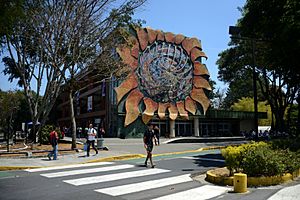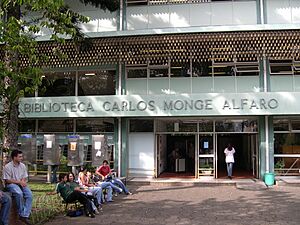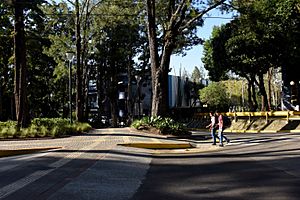University of Costa Rica facts for kids
|
Universidad de Costa Rica
|
|
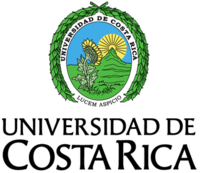 |
|
|
Other name
|
UCR |
|---|---|
| Motto |
Lucem Aspicio
|
|
Motto in English
|
"In search for the light" |
| Type | Public, undergraduate, graduate. |
| Established | August 26, 1940 |
| Budget | CRC 353 711 000 000,00 (610M USD) |
| Rector | Gustavo Gutiérrez Espeleta |
|
Academic staff
|
3,006 |
| Students | 42,750 (2018) |
| Undergraduates | 39,801 |
| Postgraduates | 2,949 |
| Location |
,
,
11501
,
9°56′09″N 84°03′02″W / 9.935833°N 84.050556°W |
| Campus | Both Urban and Rural |
| Campus size | 77.5 ha, 775.000 m2 |
| Colours | Sky blue and white |
|
Sporting affiliations
|
CF Universidad de Costa Rica |
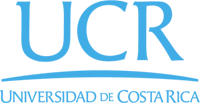 |
|
The University of Costa Rica (which people often call UCR) is a big public university in Costa Rica, a country in Central America. Its main campus is called Ciudad Universitaria Rodrigo Facio. You can find it in San Pedro Montes de Oca, which is in the San José area.
UCR is the oldest and largest university in Costa Rica. It first started way back in 1843 as the Universidad de Santo Tomás. Today, about 45,000 students attend UCR every year.
Contents
- History of UCR: A Journey Through Time
- Applying to UCR: What You Need to Know
- UCR Campuses: Learning Across Costa Rica
- UCR's Role in Society
- UCR's Reputation and Rankings
- Working with Other Countries
- How UCR is Organized
- Research at UCR: Discovering New Things
- Events at UCR
- Getting Around Campus
- Notable People from UCR
- See also
History of UCR: A Journey Through Time
The very first university in Costa Rica was the University of Saint Thomas. It opened in 1843. This old university was closely connected to the Roman Catholic Church. In 1888, the government decided to close it down. This was part of a plan to make public education more modern.
However, some parts of the old university kept going. The schools for law, farming (agronomy), fine arts, and medicine (pharmacy) continued on their own. Then, in 1940, these four schools came back together. They formed the modern University of Costa Rica (UCR) we know today.
How UCR Grew Over the Years
For a long time, UCR was the only university in Costa Rica. But then, other public universities started to open. The Costa Rica Institute of Technology opened in 1972. The National University of Costa Rica opened in 1973.
Later, in 1979, the Distance State University opened. This university was special because students could learn from far away, like the British Open University. The newest public university, the National Technical University, opened in 2008. It was formed by combining several trade schools. Today, Costa Rica has five public universities. There are also about fifty-three smaller private ones. But UCR is still the biggest and gets the most funding.
Applying to UCR: What You Need to Know
If you live in Costa Rica and want to go to UCR, you need to take an admission test. This test is a bit like the SAT test in the United States. Your score on this test is combined with your high school grades. This helps the university decide if you can get in. It also helps them figure out which major you can study and if you need financial help.
The highest score you can get on the test is 800. You need at least 442 points to be accepted. Students who score 800 are often celebrated in Costa Rican newspapers!
Getting Into Your Chosen Major
Getting into UCR is quite competitive. Only about 25% of students who apply get accepted. For example, in 2009, over 31,000 students took the test. But only about 16,500 scored high enough to be admitted.
Even if you get into the university, it doesn't always mean you get into your first-choice major. In 2007, only 60% of admitted students got into their preferred program. The other 40% had to take other classes. They hoped these classes would help them raise their grades. This way, they could later get into the major they really wanted.
Applying from Other Countries
If you are an international student, you need to get your high school certificates approved. This is done by the Ministry of Public Education in Costa Rica. After that, you can apply and take the admission test. If you want to go to Graduate school at UCR, you also need to get your college degree approved.
UCR Campuses: Learning Across Costa Rica
UCR's main campus is huge, covering about 100 hectares (247 acres). It's located in San Pedro, San José, and is called the Rodrigo Facio campus. But UCR also has other campuses around the country. This helps more Costa Ricans get a university education.
Regional Campuses and Branches
- Western Campus: This campus is in San Ramón, Alajuela. It also has a smaller branch in Tacares, Grecia.
- Atlantic Campus: Located in Turrialba, Cartago. It has branches in Paraíso, Cartago, and Guápiles, Limón.
- Guanacaste Campus: You can find this one in Liberia, Guanacaste. It has a branch in Santa Cruz.
- Limon Campus: This campus is in Port Limón, Limon.
- Pacific Campus: Located in Puntarenas, Puntarenas.
- Golfito Campus: This campus is on the southern Pacific coast, in Golfito, Puntarenas.
The main campus in San Pedro offers the most different types of courses. It also has the Medical School and programs for advanced degrees.
UCR's Role in Society
The University of Costa Rica is an important part of Costa Rican life. It sees itself as a place that welcomes everyone and focuses on human values. The university strongly encourages students to do social work and research. To graduate, most students must complete something called Trabajo Comunal Universitario (University Community Service). This program is organized by the university.
UCR is highly respected in Costa Rica. It is often mentioned in the news. The university's ideas on science, ethics, and money matters greatly influence the country's policies. Costa Rican law even requires the country's Congress to ask for UCR's opinion before approving new laws.
Many important people have studied at UCR. These include Oscar Arias, who won the Nobel Peace Prize, and several former presidents of Costa Rica. Many government leaders and heads of public organizations also went to UCR.
UCR is also part of the Consejo Nacional de Rectores. This group checks the quality of higher education. It also decides if university degrees from other countries are valid in Costa Rica.
For many years, UCR helped train the skilled workers needed for new public organizations. These included the Instituto Costarricense de Electricidad (ICE), which handles electricity, and the Costa Rican Social Security Fund (CCSS).
UCR's Reputation and Rankings
| University rankings | |
|---|---|
| Global – Overall | |
| QS World | 511-520 |
| THE World | 601-800 |
| Regional – Overall | |
| QS Latin America | 19 |
| THE Latin America | 37 |
The University of Costa Rica is known for being a top university. It is ranked as the best university in Central America and the Caribbean. It is also ranked 19th in all of Latin America. Worldwide, it is ranked between 511th and 520th by the QS World University Rankings. Another ranking, the Webometrics Ranking of World Universities, places UCR 4th in Central America and the Caribbean, 28th in Latin America, and 844th globally.
Working with Other Countries
UCR works with many international groups and governments. These include the DAAD (from Germany), and the governments of Japan, France, Mexico, Spain, Taiwan, and the European Union. It also works with the OAS and research groups in the United States. For example, the Organization for Tropical Studies has its Costa Rican office on UCR's main campus.
University Partnerships
UCR also has partnerships with many other universities. Some of these are the University of Florida, State University of New York at Albany, University of Texas at Austin, University of Illinois, University of Maryland, Rutgers University, and the University of Kansas. The agreement with the University of Kansas is the oldest one between two universities in the Western Hemisphere!
UCR has academic connections with over 41 countries. These include (in alphabetical order): Argentina, Austria, Belgium, Bolivia, Brazil, Canada, Chile, Colombia, Cuba, Denmark, the Dominican Republic, Ecuador, El Salvador, Finland, France, Germany, Honduras, Iceland, Israel, Italy, Japan, Jamaica, Mexico, the Netherlands, Nicaragua, Norway, Panama, Peru, Portugal, Puerto Rico, Russia, South Korea, Spain, Sweden, Switzerland, Taiwan, Uruguay, the United Kingdom, the United States, and Venezuela.
How UCR is Organized
UCR is divided into six main areas of study. These are Agricultural Sciences, Arts and Letters, Basic Sciences, Engineering, Health, and Social Sciences. These areas are further divided into colleges, schools, departments, and research centers. The university also offers master's and doctorate degrees in many different subjects.
Research at UCR: Discovering New Things
The university has many research institutes, about 42 of them! These institutes are where scientists and students work to discover new things. They study everything from plants and animals to human health and technology. For example, some centers focus on food science, materials, or even space. One famous institute is the Clodomiro Picado Institute, which studies snake venom and makes antivenom.
Events at UCR
The school year at UCR runs from March to December. It is divided into two main semesters. There is also an extra summer term from January to February. This summer term might be required for some students, depending on what they are studying.
Fun Activities and Showcases
Semana U is a special event held during the first semester. Different student groups take part in it. There are concerts, talks, art shows, and many other fun activities.
The Expo UCR, sometimes called la Expo, happens every two years. It's a big event that shows off all the amazing work and new ideas coming from the university.
Getting Around Campus
UCR has a free shuttle bus that helps students move around the main campus. It connects the main areas with research buildings, sports fields, and laboratories. These areas are sometimes separated by a river or neighborhoods.
Notable People from UCR
Many famous and important people have either studied or taught at the University of Costa Rica.
Alumni (People who studied here)
- Josette Altmann Borbón, former First Lady of Costa Rica
- Oscar Arias, former president of Costa Rica and a Nobel Peace Prize winner
- Laura Chinchilla, former president of Costa Rica
- Luis Guillermo Solís, former president of Costa Rica
- Carlos Alvarado Quesada, former president of Costa Rica
- María Luisa Ávila Agüero, a former Minister of Public Health
- Jeanette Benavides, a doctor in physical chemistry who worked for NASA
- Helio Fallas, a former Vice President of Costa Rica
Faculty (People who taught here)
- Marco Antei, a mathematician
- Juan Bernal Ponce, an artist
- Margarita Bertheau, an artist
- Dinorah Bolandi, an artist
- Maria Eugenia Bozzoli, an anthropologist
- Víctor Cañas, an architect
- Bélgica Castro, an actress
- Lola Fernández, an artist
- Helio Gallardo, a philosopher
- Virginia Grutter, a writer
- Alice L. Pérez Sánchez, a former Vice-Dean of Research
- Montserrat Sagot, a sociologist
See also
 In Spanish: Universidad de Costa Rica para niños
In Spanish: Universidad de Costa Rica para niños


